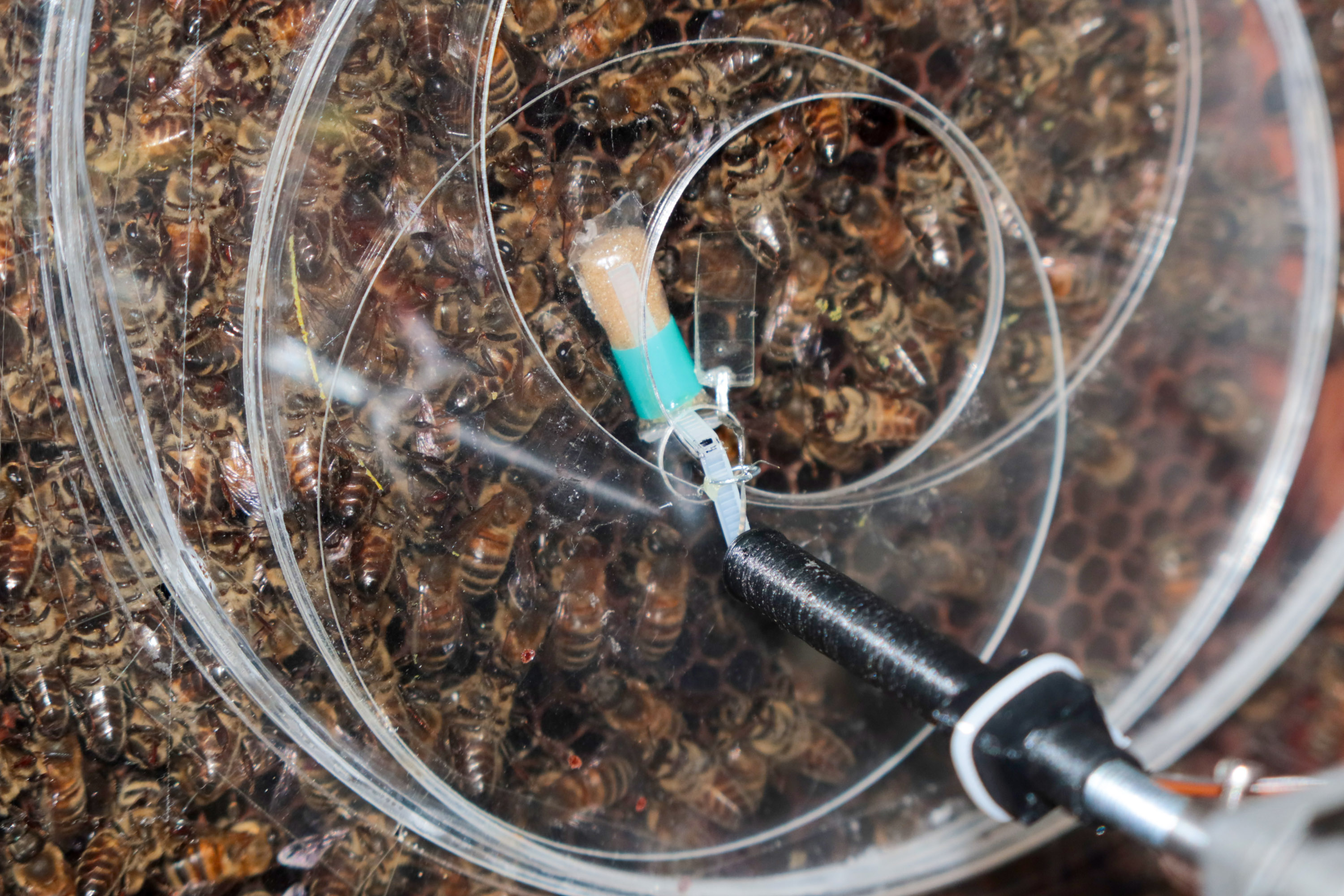How robotic honeybees and hives could help the species fight back
Robots that can monitor conditions in a hive, do a waggle dance, or even infiltrate the queen’s court could help scientists influence the health of a colony.
Something was wrong, but Thomas Schmickl couldn’t put his finger on it. It was 2007, and the Austrian biologist was spending part of the year at East Tennessee State University. As he made his daily walk across some fields to campus, “it felt unpleasant,” he says. “And I didn’t realize why until I heard a bumblebee.”
Insects, he realized, had otherwise seemed conspicuously absent. “I was dragging the biology professors out of the building and saying, ‘Look in the sky—there is nothing flying!’” he recalls.
Schmickl, who now leads the Artificial Life Lab at the University of Graz in Austria, wasn’t wrong. Studies in various parts of the world have since found that insect populations are declining or changing. After working in the field of swarm robotics for several years—using nature to inspire robots—Schmickl decided to flip his work around and design robots to help nature, a concept he calls ecosystem hacking.
He’s focusing on bees. Honeybees and other pollinators face habitat loss, pesticide exposure, and other challenges, and Schmickl believes that coming to their aid could help strengthen entire ecosystems. Already, some companies offer augmented beehives that monitor conditions inside, or even robotically tend the bees. Now Schmickl and his colleagues want to go a step further and use technology to manipulate the insects’ behavior.
Speaking to the swarm
Schmickl’s team is building prototype hives as part of a European Union–funded project called Hiveopolis. One of the group’s hives resembles a stylized tree trunk, similar to a hollow tree where honeybees might nest in nature. In an effort to use sustainable materials, that hive is made from 3D-printed clay and from fungus grown on recycled coffee grounds, Schmickl says.
The prototype hives are outfitted with sensors and cameras as well as devices that can create vibration inside the hive and adjust temperature or air flow. Such tools could ultimately direct the bees’ traffic patterns: Schmickl’s experiments have shown that vibration slows the bees down, while moving air encourages them to walk away.
Hiveopolis collaborator Tim Landgraf, a professor of artificial and collective intelligence at Freie Universität Berlin in Germany, is working on another kind of tool for these hives: a robotic dancing bee.
When real honeybees return from foraging, they perform a distinctive “waggle dance” that communicates the location of the food. Other bees join in the foragers’ dances, and when enough bees are doing the same dance, they’ll fly out to find the food. “It’s a sort of opinion polling process,” Schmickl says.
In earlier research, Landgraf built a robot that could perform a waggle dance so convincing that other bees followed it—and, at least sometimes, flew in the direction the robot suggested. Now he’s getting ready to test an improved version of the waggle robot and find out whether it can guide honeybees to a food source. The robot doesn’t look very bee-like to a human eye. Its body is simply a small, flexible tube with a fluttering “wing.” But it’s connected to a motor outside the hive that can steer and shimmy it across the hive’s dance floor.

In theory, such a robot could guide honeybees to a safe foraging site if humans determined that another site was contaminated with pesticides and was affecting the hive’s health, for example, Schmickl says. Or humans could direct honeybees away from a site that was being reserved for wild bees.
Landgraf’s group has also created a system that can observe real honeybee dances and translate them into a map. Someday, cameras inside a hive might spy on dancing bees to monitor where the bees are foraging. If a colony became sick from exposure to a pesticide or other toxin, humans might be able to figure out where that exposure was happening. “In this way, you can use the bees as an environmental detector for detrimental substances,” Schmickl says.
In the queen’s court
Through another EU project, called RoboRoyale, Schmickl and others hope to use robotic bees to influence the queen and thereby improve the fitness of the whole colony. The idea is for robots to infiltrate the queen’s group of closest attendants. In theory, the impostor bees might be able to induce the queen to lay more eggs by feeding her more protein-rich food. Or they could make her egg laying more efficient by guiding her to areas of the nest where cells for babies have already been prepared.
Schmickl hasn’t started testing these ideas in the lab yet; he’s still working on introducing potential robot materials into hives and seeing whether worker bees attack them. “Bees are picky about what materials they accept in their hive,” he says.


Elina L. Niño, associate professor of cooperative extension in apiculture at the University of California, Davis, says that at this moment, the methods in the European projects don’t have an obvious application for commercial beekeeping in the United States. The beekeepers she works with “would just kind of chuckle at this,” Niño says.
For one thing, she says, farmers and beekeepers in California work closely together. Growers alert beekeepers before spraying their crops—no six-legged pesticide detectors required. And she’s not sure that producing more baby bees from a hive is as simple as feeding a queen more protein.
It makes more sense to focus instead on creating healthier environments for bees, Niño says, “so we don’t have to be concerned with regulating their flight and their foraging.”
However, “from a research perspective,” Niño adds, the European work is “super exciting.” Observing how honeybees interact with the waggle robot, for example, could give scientists new insights into bee communication.
She also thinks the technologies that Schmickl and his colleagues are pursuing might be more attractive to hobbyists than to professionals. Schmickl says making beekeeping more appealing and accessible is one of his goals—for example, if bees could be induced to move out of a certain comb, a user could access it without needing protective gear.
“Whether it’s beekeepers that use it or recreational hipsters on their balcony, I don’t really care,” Landgraf says.
“Humans are waking up to how important nature is,” he adds. We may think of technology as being on the opposite end of the spectrum from nature, he says, but that doesn’t have to be true: “It should be an interface that augments our and nature’s capabilities.”
Deep Dive
Biotechnology and health
How scientists traced a mysterious covid case back to six toilets
When wastewater surveillance turns into a hunt for a single infected individual, the ethics get tricky.
An AI-driven “factory of drugs” claims to have hit a big milestone
Insilico is part of a wave of companies betting on AI as the "next amazing revolution" in biology
The quest to legitimize longevity medicine
Longevity clinics offer a mix of services that largely cater to the wealthy. Now there’s a push to establish their work as a credible medical field.
There is a new most expensive drug in the world. Price tag: $4.25 million
But will the latest gene therapy suffer the curse of the costliest drug?
Stay connected
Get the latest updates from
MIT Technology Review
Discover special offers, top stories, upcoming events, and more.